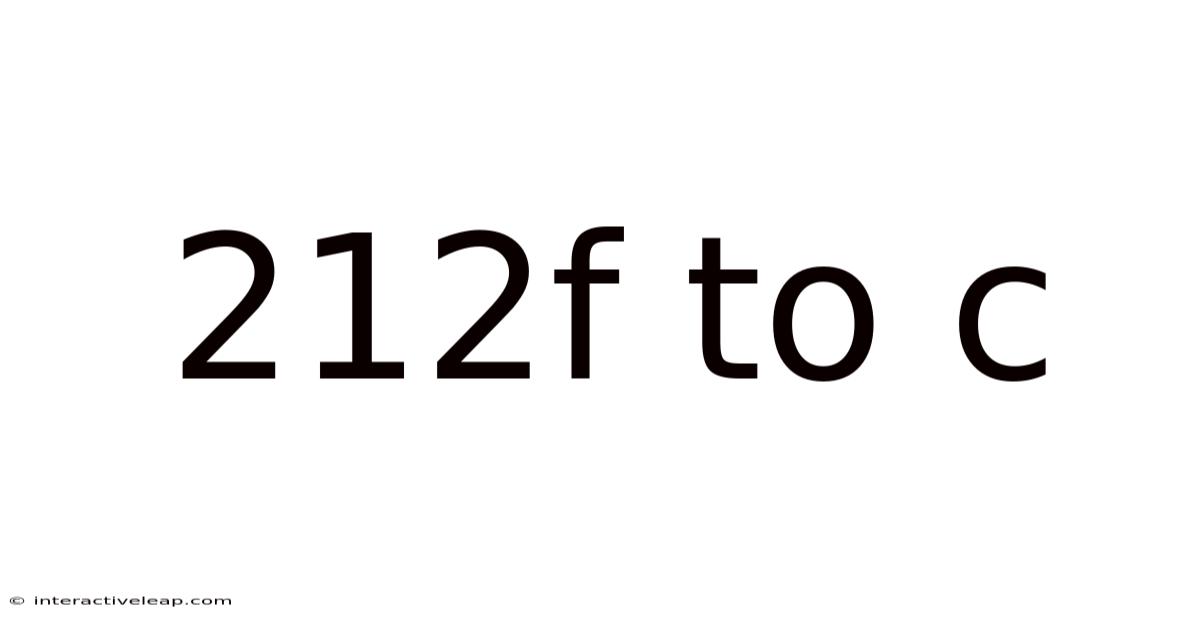212f To C
interactiveleap
Sep 20, 2025 · 4 min read

Table of Contents
Converting 212°F to Celsius: A Comprehensive Guide
Knowing how to convert Fahrenheit to Celsius is a fundamental skill, especially if you work in a field that uses both temperature scales, or if you simply want to understand global weather reports or cooking instructions. This article will delve into the conversion of 212°F to Celsius, exploring the underlying formula, offering step-by-step instructions, and providing additional context and examples. We'll also touch upon the scientific principles behind these temperature scales and answer frequently asked questions.
Understanding Fahrenheit and Celsius
The Fahrenheit (°F) and Celsius (°C) scales are two different ways to measure temperature. Fahrenheit, developed by Daniel Gabriel Fahrenheit in the early 18th century, is still commonly used in the United States, while Celsius (°C), or Centigrade, is the preferred scale used internationally and in most scientific contexts.
The key difference lies in their reference points:
- Fahrenheit: Freezes at 32°F and boils at 212°F at standard atmospheric pressure.
- Celsius: Freezes at 0°C and boils at 100°C at standard atmospheric pressure.
The Conversion Formula: From Fahrenheit to Celsius
The formula to convert Fahrenheit to Celsius is:
°C = (°F - 32) × 5/9
This formula essentially adjusts the Fahrenheit reading to account for the different freezing and boiling points of water in each scale. Subtracting 32 accounts for the difference in the freezing point (32°F vs 0°C), and multiplying by 5/9 scales the remaining range to fit the Celsius scale.
Step-by-Step Conversion of 212°F to Celsius
Let's apply the formula to convert 212°F to Celsius:
-
Substitute the value: Replace °F with 212 in the formula: °C = (212 - 32) × 5/9
-
Solve the parentheses: Subtract 32 from 212: °C = (180) × 5/9
-
Perform the multiplication: Multiply 180 by 5: °C = 900/9
-
Perform the division: Divide 900 by 9: °C = 100
Therefore, 212°F is equal to 100°C. This makes intuitive sense, as 212°F is the boiling point of water, which corresponds to 100°C.
Why This Conversion Matters
Understanding Fahrenheit-Celsius conversions is crucial in various situations:
- International Communication: Sharing temperature information with people from different countries requires conversion to ensure clarity.
- Scientific Research: Scientific experiments often require precise temperature control and reporting using the Celsius scale.
- Cooking and Baking: Many recipes use Celsius, so understanding the conversion is necessary for accurate results.
- Global Weather Reports: International weather reports usually use Celsius, making conversion essential for comprehension.
- Engineering and Manufacturing: Many industrial processes require precise temperature control, often using the Celsius scale.
Beyond the Formula: A Deeper Dive into Temperature Scales
While the formula provides a straightforward method for conversion, understanding the underlying principles can enhance comprehension. The formula's structure reflects the ratio of the temperature ranges between the freezing and boiling points of water in each scale.
The Celsius scale is considered a more logical scale because it's based on the fundamental properties of water. The 100-degree range between freezing and boiling allows for easy calculations and divisions into smaller increments. Fahrenheit, although widely used historically, lacks this inherent simplicity.
Examples of Fahrenheit to Celsius Conversions
Let's look at a few more examples to reinforce the understanding:
-
Converting 68°F to Celsius: °C = (68 - 32) × 5/9 = 36 × 5/9 = 20°C (a comfortable room temperature)
-
Converting 32°F to Celsius: °C = (32 - 32) × 5/9 = 0 × 5/9 = 0°C (the freezing point of water)
-
Converting 0°F to Celsius: °C = (0 - 32) × 5/9 = -32 × 5/9 = -17.78°C (a very cold temperature)
-
Converting 20°F to Celsius: °C = (20 - 32) × 5/9 = -12 × 5/9 = -6.67°C
Frequently Asked Questions (FAQ)
-
Q: Can I use this formula for temperatures below freezing? A: Yes, the formula works for temperatures below 0°C (32°F) as well. You will obtain a negative value in Celsius.
-
Q: Are there any online calculators for Fahrenheit to Celsius conversions? A: While this article provides the manual calculation, many online tools provide quick and easy conversions.
-
Q: What is the absolute zero point in Celsius? A: Absolute zero, the theoretical lowest possible temperature, is -273.15°C.
-
Q: Why is Celsius preferred in scientific contexts? A: The Celsius scale's logical structure based on water's properties makes it more convenient and consistent for scientific measurements.
-
Q: Is there a formula for converting Celsius to Fahrenheit? A: Yes, the inverse formula is: °F = (°C × 9/5) + 32
Conclusion
Converting 212°F to Celsius is straightforward using the formula (°F - 32) × 5/9. This results in 100°C, the boiling point of water. Understanding this conversion is crucial for various applications, from everyday life to scientific research. While the formula provides a simple method, understanding the underlying principles of the Fahrenheit and Celsius scales helps to solidify comprehension. Remember to always double-check your calculations to ensure accuracy, especially in situations where precision is paramount. This knowledge empowers you to navigate a globalized world where different temperature scales coexist. Practice using the formula with different temperatures to build confidence and proficiency in your understanding of temperature conversion.
Latest Posts
Latest Posts
-
Keep Right Sign
Sep 20, 2025
-
Push Factors Def
Sep 20, 2025
-
65 Cm Feet
Sep 20, 2025
-
Translate By Vector
Sep 20, 2025
-
3 20 As Decimal
Sep 20, 2025
Related Post
Thank you for visiting our website which covers about 212f To C . We hope the information provided has been useful to you. Feel free to contact us if you have any questions or need further assistance. See you next time and don't miss to bookmark.